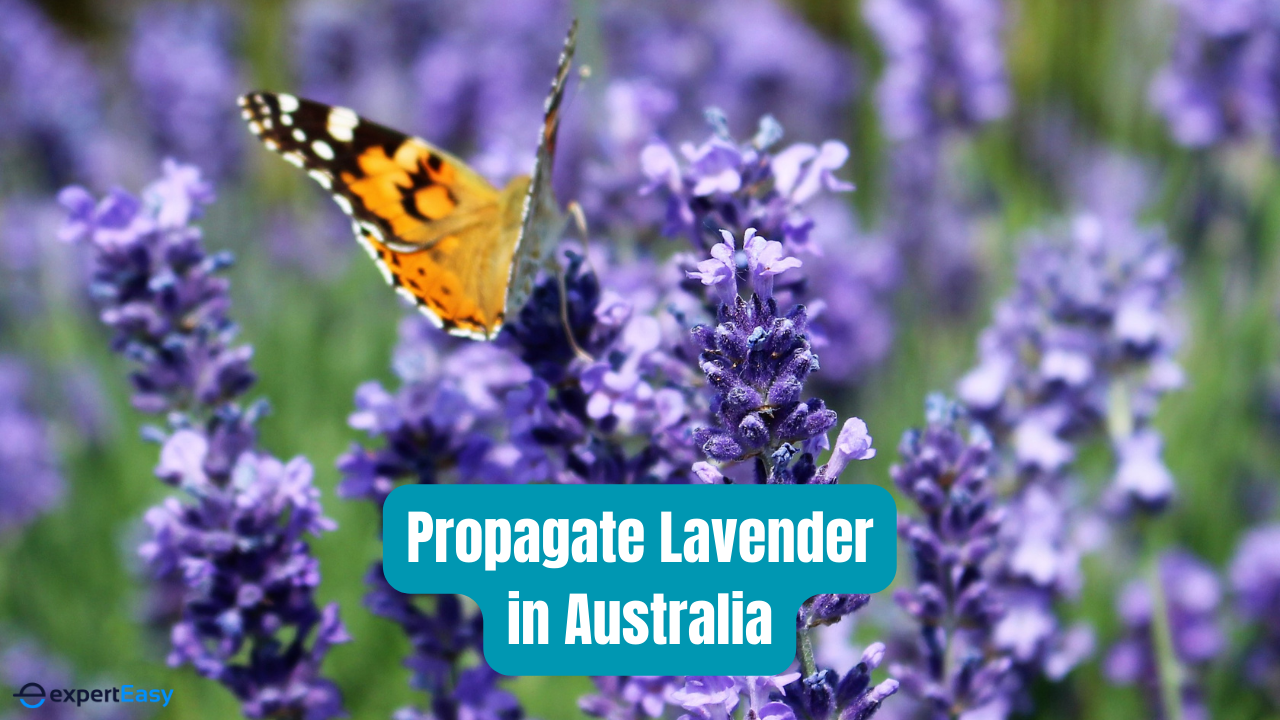What better way to add a mid-summer mix of colour to your patio or garden than propagating lavender? The plant, renowned for its myriad benefits, has been prized for centuries due to its medicinal properties. And its striking beauty and delightful aroma make it a desirable addition to any garden.
Any Australian garden without lavender is going to feel something missing in its makeup. Particularly given the fact that it can be easily cultivated from cuttings. It can also be propagated via seeds. Although that requires a tad more patience – approximately eight weeks for germination.
Ready to fill your garden with its fragrant lilac blooms? We'll dive right into the nitty-gritty of propagating lavender in Australia and expert insights on nurturing its growth.
About Lavender Plants

Before mastering how to propagate lavender in Australia, you need to understand how to grow and care for the plant. Here’s everything you need to know about propagating lavender:
Climate Conditions
Lavender flourishes in warm and sunny climates. Its natural habitat is the Mediterranean region, characterised by mild winters and dry summers. In Australia, lavender can thrive in most climate zones, except for the tropical regions where excessive humidity may hinder its growth.
Soil & Drainage
Lavender grows best in alkaline soil, enjoying a pH ranging from 6.5 to 7.0. A soil test kit can help you determine the pH of the soil in your garden and make the necessary adjustments.
The ideal soil texture is sandy or loamy because it allows for good drainage. Lavender is a plant that can't tolerate waterlogged conditions, so good drainage is paramount. If your garden has heavy or poorly draining soil, consider planting your lavender in raised beds for better control over the soil conditions.
Organic matter can also help improve soil structure and moisture retention of the soil in your garden. You can achieve this by adding well-rotted manure or compost into the soil.
Watering
When initially planted, lavender needs plenty of water to thrive, but it should drain off very well. Standing water, particularly during winter dormancy, can be detrimental. Once established, lavender requires less frequent watering, with the soil allowed to dry out in between to prevent waterlogging.
Best Species for Propagating Lavender
There are at least 45 species of lavender cultivated globally, with numerous varieties available. The following are some of the best options for Australian gardeners:
English Lavender
Unlike its name suggests, this species hails from the Mediterranean. It grows wild on mountainsides of the Mediterranean but has been popular in English gardens for decades. It is an outdoor perennial in temperate climates and has narrow leaves. The flowers of the English lavender have the strongest aroma compared to the other parts of the plant.
French Lavender
This graceful lavender species with indented leaves is a native of the Mediterranean region. It looks somewhat similar to the English lavender but has leaves with dentate margins. Its flowers arch on long stems with fragrant light purple flowers and a hop-like head. Requiring brighter sun, richer soil, and a touch more water than other varieties, this species can be cultivated upright or trained to cascade.
Portuguese Lavender
If you are looking for an appealing, rare variety, look no further than Portuguese lavender. It is a heat and drought-tolerant variety that’s suitable for more tropical climate zones in Australia. Thus, the variety is relatively low-maintenance. All you have to do is allow the soil to dry between waterings.
Lavandin
This variety has very similar qualities to lavender. But it’s a hybrid of the lavender species. Lavandin is more penetrating than lavender. It has a strong scent, and it’s considered to be beneficial for circulatory, respiratory, and inflammation conditions. Lavandin usually has three flower heads in each stem. It also has longer lilac flowers and longer stems.
How to Propagate Lavender From Cuttings

Lavender is a very easy plant to propagate from cuttings. All you need are cuttings, a propagating mix, and a warm position until they establish a good root system. Ideal timing for cuttings is in the early spring, although late winter can also be feasible, provided you have a form of cover offering sufficient warmth and cold protection. Let's walk through the process with a few easy-to-follow steps.
Taking Lavender Cuttings
Before you start, you will need the following:
- A mature lavender plant
- Flats or trays filled with rooting medium
- Secateurs, scissors, or sharp knife
- Rooting hormone
- Somewhere sunny and warm to keep your cutting trays or flats
What you are looking for in a cutting is a stem with a heel. Take cuttings from softer growth because they will root more easily than woody, hardened growth.
Use a sharp knife to cut just underneath a leaf node or where leaves grow from the stem. Then, strip the leaves off the stem until you’ve passed two leaf nodes. Cut the upper part, leaving only two leaves on the cutting that will help with transpiration. Preferably, the cuttings should be three to five inches long.
Propagating the Cuttings (Rooting in Soil)
The ideal propagating mix or rooting media for growing lavender from cuttings should be a mixture of potting mix or compost (1/3), coir peat or peat moss (1/3), and vermiculite (1/3). This light, airy mixture retains moisture, which is good for root development.
Dip the bottoms of your cuttings into a rooting hormone or powder. This helps stimulate the roots to grow. Then, gently insert the cuttings into the rooting medium until your trays are full. Once the cuttings are in, you need to mist them with a light spray of water to keep them moist. Keep the propagated cuttings in a warm position until they start showing signs of growth.
Depending on the temperature, the cuttings will start rooting in about four to six weeks. You will know if the roots are developing by gently tugging on the cuttings. A slight resistance indicates that the roots are developing. Once they are established, you can transfer your lavender plants into larger containers. Give the plants another watering session and snip off any flowers that might have started to grow.
Propagating the Cuttings (Rooting in Water)
Suppose you have your cuttings from the previous step on taking lavender cuttings. In that case, fill a glass or jar with clean water and place the stem in it. Make sure the stem is submerged in the water while keeping the leaves above the waterline. If desired, you can use a rooting hormone to encourage faster root development, although it is not necessary. You must also find a warm and bright location for the cutting, but avoid direct sunlight as it can be too intense. Change the water every few days to keep it fresh and prevent the growth of harmful bacteria.
Over the course of a few weeks, roots should start to develop from the submerged part of the stem. Be patient and allow the roots to grow to a reasonable length, typically around 1-2 inches, before proceeding to the next step. Once the roots have grown, carefully remove the cutting from the water and plant it in a well-draining potting mix. Choose a pot with good drainage and place the lavender cutting in it. Position the pot in a sunny spot and water it regularly, ensuring that the soil is moist but not waterlogged.
How to Propagate Lavender From Seeds

Growing lavender from seeds may not be as straightforward as growing from cuttings. But if you must, the plate method is the most reliable approach to germinating the seeds. Put a napkin or paper towel on a plate and moisten it with water. It should be wet but not waterlogged. Sprinkle the seeds onto the moistened napkin or paper towel and avoid clumps. Put the plate sprinkled with lavender seeds into a ziplock bag and refrigerate for thirty to forty days. The refrigeration trick helps recreate winter conditions.
After thirty to forty days, take the plate out of the fridge and place it near a sunny window. Lavender seeds need sufficient light to germinate. The seeds should germinate in seven to fourteen days. Carefully pick up the germinated seeds from the wet napkin or paper towel and plant them in potting soil. Be gentle to avoid damaging the fragile seedlings. Press lightly around the planted seedlings to firm up the soil around them.
In about eight to twelve weeks, you should see lush lavender growth. The new lavender plants will need plenty of sunlight.
How to Propagate Lavender Through Layering

This technique involves burying a stem from the parent lavender plant and allowing it to develop roots while still attached to the parent plant. To begin the process, select a healthy and flexible low-lying stem from the parent lavender plant. Next, prepare the selected stem by removing any leaves or lateral branches from the lower portion. You want to create a clean section of stem that will be buried in the soil. This will allow the stem to develop roots more easily.
Dig a small trench or furrow near the parent plant where you will bury the prepared stem. Then gently bend the stem down towards the trench and bury the prepared section of the stem in the soil. Leave the tip exposed above the ground. You can use garden stakes or small rocks to hold the stem in place and ensure it remains in contact with the soil. From here, water the area thoroughly to settle the soil and provide moisture to the buried stem.
Over time, usually several weeks to a few months, the buried section of the stem will develop roots. You can monitor the progress by gently tugging on the stem to check for resistance, which indicates root growth. Once you see significant root development, carefully cut the stem below the rooted section using clean and sharp pruning shears. Dig up the new lavender plant with its established root system and gently separate it from the parent plant. Be careful when handling the new plant to avoid damaging the delicate roots.
Common Problems of Lavender
Lavender is generally a resilient plant, but it's still liable to some common problems that may affect its health and appearance. Here are a few of them:
1. Overwatering or poor drainage
Lavender prefers well-draining soil, and excessive moisture can lead to root rot and other fungal diseases. It's important to water lavender sparingly and ensure that the soil is allowed to dry out between waterings.
If the soil doesn't have proper drainage, it can lead to waterlogged roots and cause issues for lavender plants. Amending the soil with organic matter or planting lavender in raised beds can help improve drainage.
2. Lack of sunlight
Lavender thrives in full sunlight, and insufficient exposure to sunlight can result in weak growth and fewer blooms. Ensure that your lavender plants receive at least six to eight hours of direct sunlight each day.
In regions with cold winters, lavender plants may experience damage or die back during the colder months. To protect lavender from winter damage, apply a layer of mulch around the base of the plant and consider covering it with a breathable fabric or moving potted lavender indoors.
3. Improper pruning
Pruning lavender is essential to promote bushier growth and prevent the plant from becoming woody. However, improper pruning, such as cutting into old wood or trimming too much at once, can harm the plant. It's best to prune lavender lightly and only trim back a third of the plant at a time.
4. Pests and diseases
While lavender is generally resistant to pests, it can occasionally attract aphids, spider mites, or root-knot nematodes. Regularly inspect your plants for signs of pests and take appropriate measures, such as using insecticidal soap or neem oil, to control infestations.
Lavender can be susceptible to diseases like powdery mildew, root rot, and gray mould. These diseases can be caused by excessive moisture, poor air circulation, or unsanitary gardening practices. Preventative measures, such as providing proper spacing between plants and avoiding overhead watering, can help minimise the risk of diseases.
Lavender Plant Care Tips
Do you want your lavender plants to grow healthy? Here are a few lavender plant care tips to consider:
- Water your lavender cuttings consistently until they develop sturdy roots. Afterward, give them a good soak but avoid waterlogging.
- Monthly application of a water-soluble flower fertiliser is advisable. Be aware, however, that lavenders fertilised regularly may produce flowers with a less potent fragrance, and the plants may become susceptible to fungal disease.
- Lavender plants like the sun. So, make sure they are in a spot where they will receive at least six hours of sunlight every day.
- Help establish lavender by cutting off any flower buds that develop in the first season. This will encourage the plant to focus on root growth.
- Mulch your lavender plants for winter protection. Mulching will help eliminate weeds, which usually compete for nutrients and space.
- It’s also important to keep your lavender plants pruned as they grow to ensure a pleasing shape. You can prune lavender plants in early spring or after flowering.
Are you planning a garden redesign or in need of some landscaping advice? Our guide on how to find the best landscaper in Australia is a great resource. These professionals provide everything from design inspiration to full-service landscaping, helping you transform your outdoor space into a beautiful garden masterpiece.
🪴Need Assistance With Gardening?
Whether you're a seasoned green thumb or just starting out in gardening, there's always more to learn. Immerse yourself in our guide to finding the perfect gardener in Australia. These top-rated professionals offer a variety of services, from plant selection to garden maintenance, ensuring your garden remains vibrant and healthy.
🌲Seeking Help With Lawn Care?
Maintaining a beautiful lawn can be a significant undertaking. If you're in need of expert assistance, look no further than our carefully curated guide on choosing the right lawn mowing service in Australia. These experts can help keep your outdoor spaces at their greenest and cleanest best with their lawn mowing and care expertise.
Frequently Asked Questions (FAQs)
Here are some frequently asked questions about lavender propagation in Australia.
What's the best time to plant lavender in Australia?
The ideal planting time for lavender in Australia is during spring or early autumn. These seasons offer moderate temperatures and more consistent rainfall, promoting good root growth before the hot summer or cold winter months.
Can lavender grow in all parts of Australia?
Lavender thrives in most Australian climate zones but may struggle in regions with high humidity, such as the tropical north. The plant prefers a Mediterranean-like climate with dry summers and mild winters.
How often should I water my lavender plants?
Once established, lavender plants typically need watering only once a week during dry periods. The plant prefers well-drained soil and doesn't tolerate waterlogged conditions. Always allow the soil to dry out between waterings.
What type of soil is best for growing lavender in Australia?
Lavender grows best in alkaline soil with good drainage. It enjoys a soil pH ranging from 6.8 to 7.0. Sandy or loamy soil types are ideal for this plant.
Does lavender need a lot of sun?
Yes, lavender plants love the sun. To grow successfully, they require a spot in the garden that receives at least six hours of direct sunlight daily.

Wrapping Up
Whether for its soothing scent or flavour, lavender is an exceptional plant to cultivate in your lawn or garden. Although you can start lavender from seeds, it’s much easier to use cuttings. All you need is a mature lavender plant, a rooting medium, some cutting tools, and somewhere warm or sunny to propagate the cuttings.
Remember to exercise patience as your cuttings develop into mature, flourishing lavender plants, providing fragrance and beauty to your garden. Where unsure, reach out to us or seek the advice or help of a gardening professional to help you diagnose and advise further.








